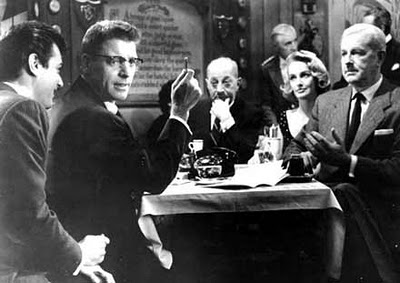Given The Sweet Smell of Success and the NRA’s post-Newtown press conference, the conventional wisdom is that public relations practitioners are oily, tone-deaf hucksters. After spending a few days catching up on reading PR trade publications, it seems we are idiots, too. The bad writing and sophomoric advice (often about how to avoid bad writing and giving sophomoric advice) that passes for professional development is shameful.
In an article about how to achieve social media success in 2013, the “secrets” included “tell your story, but tell the true story well;” “recycle your content;” and “pay attention to Google’s algorithm.” In another I learned if you want to be a successful entrepreneur, you should have the key traits of persuasion, leadership and personal accountability. Wow.
I was recently part of a discussion thread on LinkedIn, “If you were advising the NRA on a communications strategy right now, what would you say?” (This was started well before the disastrous “armed guards in schools” press conference.) It was a lively and robust conversation, with some terrific thoughts, but I was shocked and dismayed by the number of posters–all crisis communications professionals–who completely and utterly missed the point.
Speaking of LinkedIn, I applied to join a group, “Network of PR Professionals.” I got this message back from the group manager: Normally, we do not accept members whose profile fotos are in violation of LI’s User Agreement, which requires any profile foto to be a head shot. Your foto is cropped so severely that LI members cannot easily distinguish your tiny face. The message went on to share Wikipedia’s definition of a “head shot” and to outline LinkedIn’s User Agreement requirements. The group manager closed by saying: Your credentials are impeccable. Once you bring your LI profile foto into compliance, please submit a new Membership Request and I will approve it immediately. I apologized for my tiny face, and asked him to do the same for “foto.” I should also have done the same for using Wikipedia as a source.
No wonder our profession has a bad name. Too many of us just do not get it, yet are still practicing and presumably getting paid. To be fair, there was one piece of advice that I will share from the “secrets” article: Get out of the PR bubble. YES! Cross the lines; read dispatches from other disciplines. I highly recommend a terrific blog called Occam’s Razor written by Google’s “digital marketing evangelist” Avinash Kaushik. His passion is data and how to best present it, which for PR is the Holy Grail–measuring ROI! From reading his posts, I have been able to devise a metric for my clients’ Facebook pages that makes sense to them and guides us in how to constantly improve the quality of our posts and the level of our engagement.
I will endeavor to do the same with my counsel.


Excellent, eloquent and to the point.
Mike–Thank you so much for the kind words.
I like the statement that…” to be a successful entrepreneur, you should have the key traits of persuasion, leadership and personal accountability”. Wow. so true. and it is applicable in every field.
I agree that is true, but my point is that should be obvious, to anyone in any field.
Cheryl, Can you expand on a couple of the points you brought up? I’m curious about the robust discussion regarding advising the NRA — what were some of the good ideas and what were the bad? It felt like a teaser headline but with no details to follow. Thanks. p.s. I loved the “foto” story. Not sure I would join that organization!
I think my favorite was made by Greg Brooks, “I think what the NRA is doing right now makes perfect sense, reflects a pre-existing and well-executed plan, and will ultimately serve their members well. (And I say all of that that *not* as an NRA fanboy.) The NRA doesn’t need to change anyone’s mind and, even if they did, it’s crisis 101 to know that the midst of a firestorm is not when you go about it.” This not coincidentally meshes with my opinion.
The worst were all variations of “The NRA needs to change its positions.” Why? They represent their members, who are members presumably because they agree with the NRA’s mission. As they say on their website “our successes would not be possible without the tireless efforts and countless hours of service our nearly four million members have given to champion Second Amendment rights and support NRA programs.”
On the “foto,” I am considering renaming this the “Tiny Face” blog as suggested by one of the LinkedIn commenters!
Thanks, Cheryl. Very interesting! I agree that it would make no sense for the NRA to change its position. I think too often we as PR people want to smooth everything over and avoid anything that could be slightly controversial. This is a great example of when NOT to interfere.
By the way, if you change your blog name to “Tiny Face” you’ll need to re-crop and resize your photo. Otherwise the PR police might come after you for being a “Large Face.” I tried to find rules for blog photo sizes on Wikipedia but no luck. 🙂
HA! Made me laugh out loud!
As the group manager who sent Cheryl that message, let me share with you the entire message she received:
==============================
Ms. Byrne,
Thank you for your interest in joining our LinkedIn group.
Normally, we do not accept members whose profile fotos are in violation of LI’s User Agreement, which requires any profile foto to be a head shot. Your foto is cropped so severely that LI members cannot easily distinguish your tiny face.
Wikipedia defines “head shot” as: “…a photographic technique where the focus of the photograph is a person’s face…As a form of identification, a head shot is a front-on (facing straight at the camera) photograph, with the face being the center of the picture and containing minimal or no surroundings.”
Head shots encourage LI’s goals of greater interaction, bonding, community-building and networking among LI members. Profile fotos without head shots (or with barely recognizable faces due to distance from camera or pose) inhibit that bonding, interaction, etc., and the impact is worsened when LI members use a logo or drawing on their profile, instead of a personal foto.
LinkedIn’s requirement of a head-shot photo for personal profiles means that the following are all prohibited from a profile’s photo field:
• Drawings
• Cartoons
• Symbols
• Logos
• Group fotos
• Distant body shots
• Full-body fotos
• Poses displaying anything below the shoulders
• Fotos of specific body parts
• Pictures of anything else other than your head, face and/or shoulders
NOTE: LI members have the option of not using any image in their profile’s foto field, leaving it blank.
You can verify this in Section 10.2.6 (“Do’s and Don’ts”) of the LI User Agreement, which states that users shall not “Upload a profile image that is not your likeness or a head-shot photo.” The User Agreement can be viewed by following its link at the bottom of any LinkedIn page, or via this direct link: http://linkd.in/F8IRX .
Your credentials are impeccable. Once you bring your LI profile foto into compliance, please submit a new Membership Request and I will approve it immediately.
Until then, I wish you good fortune—
Steven Spenser
Group Manager
Network of PR Professionals
Notice the emphasis in the fourth graf above:
“Head shots encourage LI’s goals of greater interaction, bonding, community-building and networking among LI members. Profile fotos without head shots (or with barely recognizable faces due to distance from camera or pose) inhibit that bonding, interaction, etc. …”
While, technically, Ms. Byrne’s foto is a head shot of her likeness, the tiny size of her foto defeats the purpose of displaying head shots alongside LI discussions and comments–namely, the promotion and encouragement of member interaction, in this case through being able to recognize members and distinguish their facial features.
Perhaps this is why Ms. Byrne apologized for her profile’s foto. Yet, despite her acknowledgement of the foto’s shortcomings, she has not seen fit to do anything about it–which is why she is still not a member of our group.
Network of PR Professionals is LinkedIn’s oldest & largest networking group devoted exclusively to the theory and practice of PR & marketing communication. With more than 21,650 members, our group (like this one) is in the top one-half of 1% of all LI groups based on size.
We are *much* more selective about whom we accept as members than most PR groups on LI, which seem to have an open admission policy, accepting practically everyone who applies.
Network of PR Professionals, in contrast, only accepts members who engage in the practice or management of PR (in its various forms) and marketing communication. I’ve seen applicants with no background in PR or marcom, no professional education in those fields–heck, even with no jobs (current or past) listed on their profiles at all–whom I have rejected for our group, yet who were permitted to join the biggest PR groups.
BTW, Ms. Byrne did not–as her blog piece claims–ask me (bizarrely) to apologize for using Wikipedia as a source (!?) for a mere definition. Here is the entire text of her response:
>>Dear Steven,
>>Thanks so much for your response. I apologize for my tiny-faced profile photo. Yet, shouldn’t you, too, be penalized for your repeated use of “foto?” <<
========================================
The journalistic slang ("foto," "led," "hed," etc.) which I continue to employ–as a matter of habit after my stints as an editor with AP and a major newspaper–in casual, private messages to fellow PR professionals, is not relevant to Ms. Byrne's membership rejection.
Why she should, as she writes here, apparently still be waiting to hear back from me is puzzling, since I had already told her in her rejection notice that the ball was now in her court.
At any rate, I still mean what I wrote to her in October: "Until then, I wish you good fortune."
Explanation of “like this one”: I had previously shared this response on a LI group (not my own) in which Ms. Byrne discussed her rejection notice. I’m guilty of cut-and-pasting without sufficient proofreading.
Steven, When I say I am still waiting, as your comment indicates, I closed with a question that had remained unanswered until you did that here. Thank you for the explanation of “foto.” In nearly 30 years in public relations, I had not encountered that usage. And while you are correct and I have edited my post accordingly, I mentioned Wikipedia to punctuate the points that I was trying to make, and that I reiterated in my response to Roger Pynne (on LinkedIn thread). We should be better.
Good article. But you date yourself with the double spacing after a period. We stopped doing that more than 20 years ago.
We did? No one told me. See what I mean about our lack of professional development? Thank you for the update! (And look, only one space! Old dogs CAN learn new tricks after all!)
Cheryl, this was entertaining and you make some great points–thanks to the NRA, in addition to the political debate, we have a great case study.
Thank you so much! And I agree about the NRA making a great case study.